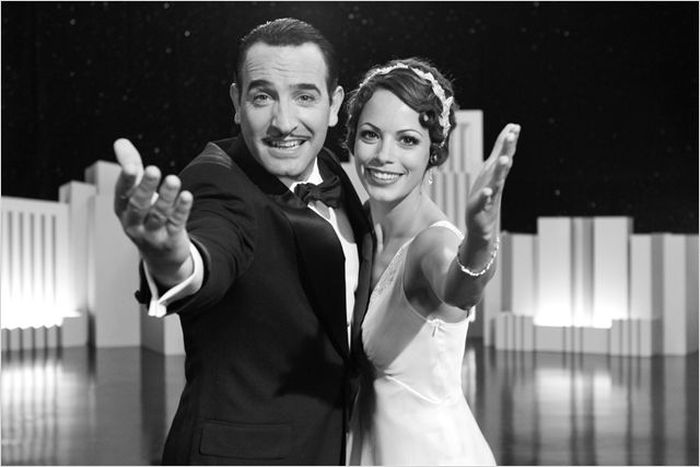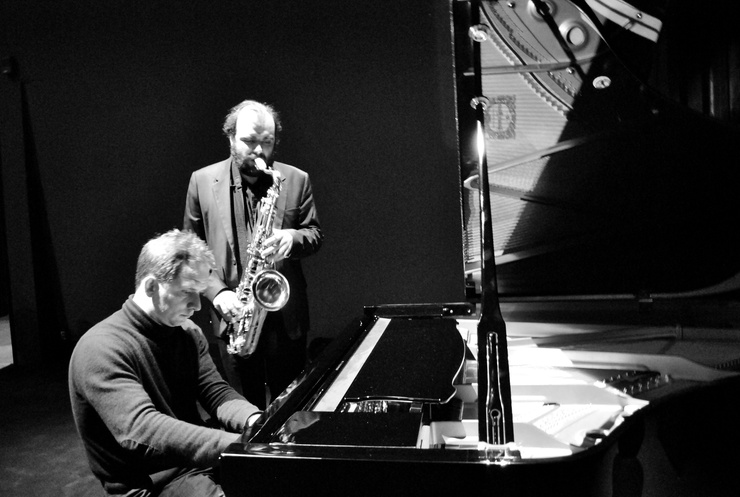
Five oscars for 'The Artist': focus on film music and silent cinema in France
Published on
Translation by:
 Tara Katti
Tara Katti
In films, music is usually relegated to the background of film production. Not so if you look back at its role in silent cinema, which has made a loud comeback with director Michael Hazanavicius' oscar winner for best film, actor and director, amongst others
The room is dark. A black and white film is projected onto the big screen. Harold Lloyd scales the floors of a skyscraper. The audience hold their breath. On the brink of the precipice, the hero gets his feet caught in a net. Disorientated, he begins a sequence of funny faces and dance steps. A collective burst of laughter. 200 pairs of hands start clapping. There’s no need for a time machine to rediscover the atmosphere of cinemas in the 1920s: it was enough to attend the cine-concert organised for the opening of the Rencontres Internationales Henri Langlois (RIHL) in Poitiers, west-central France, between 2 - 11 December 2011.
War declared on new wave
At the event, Karol Beffa (piano) and Raphaël Imbert (saxophone) improvise on one of the classics of silent cinema, Safety Last ('Monte là-dessus', 1923). 'Previous years have been dedicated to screenplay, photography and editing,' says Luc Engélibert, the artistic director of the event. 'It was logical to concentrate on film music this year. I asked Karol Beffa to come as I wanted someone capable of providing a true reflection on improvisation, and thus bring out the meaning of the work without betraying it.'
The genius of the keyboard, who received the young composer prize from Sacem (society of authors, composers and editors of music) in 2008, was given carte blanche. He brought his friend Raphaël Imbert with him, offering a tasty performance mixing classical and jazz. Nostalgic for the golden age of silent films, both denounce the 'divorce' between their art and cinema. 'In France, it all started with the new wave. The music was nothing more than furniture,' Raphaël recounts. From reference to reference, the jazzman turns out to be a real living encyclopaedia. 'In the era of silent cinema musicians improvised on the films. It was necessary to alternate between all styles: polka, mazurka, baroque and even country music. The sound effects were done live, often by small orchestras present in the room. The audience could react immediately.'

The Artist: golden globe, goya and oscar winner
The success of The Artist, which has won awards at the 2011 Cannes film festival, 'best European film' at the Spanish goyas and five oscars, shows a certain curiosity about the roaring twenties. Come to present the inaugural lecture of the Henri Langlois meeting, the director Michel Hazanavicius explains he had flirted with the cinematic pilgrimage during filming. 'I happened to find myself in some incredible places like Charlie Chaplin’s office, the studios where his films The Gold Rush (1925) and Modern Times (1936) were filmed, backdrops which were used for the film Casablanca (1942). All of these things are very moving.' However, a return to the times of live chamber orchestras in dark cinemas seems unlikely. French composer Ludovic Bource’s original soundtrack is seen rather as a tribute to hollywood standards of the early century, without revolutionary pretension.
Importance of soundtrack
If sound remains illustrative, 'like violins in a love scene, very kitsch', it is a bad omen for Pierre-Louis Umdenstock, who says that the 'melody should comment upon the image'. Trained in Chicago, the 25-year-old Parisian director takes an example from the Quentin Tarantino film Reservoir Dogs (1992). 'I’m thinking of the torture scene, when the guy gets his ear cut off to folk background music. It’s vicious.' Wanting to jig about when a bloody head bleating with pain is facing you can, in fact, make the spectator more uneasy. Guaranteed effect.
Within the seventh art family, the older and younger generations do not always agree. Mexican director Arturo Ripstein, who has around fifty films under his belt spread over more than four decades, believes that the melody is too often an 'easy solution' for the director. 'I have already told the audience what to think with images, the notes compel the emotion.' Yet, in reality, Ripstein also needs this 'device' and has collaborated with the American composer David Mansfield for about ten years. 'I whistle the tune to him on skype and he transcribes it,' Ripstein describes with an imperious air. Yet even if music sounds like an increasingly integral part of film production, the director remains the boss - of the orchestra, perhaps.
Images: main © Warner Bros France ; in-text © Laurène Daycard; video Safety Last (cc) lesbellesmanières, The Artist(cc) Warner Bros France / youtube
Translated from Oscars 2012 et The Artist : « oh putain génial », c'est muet


